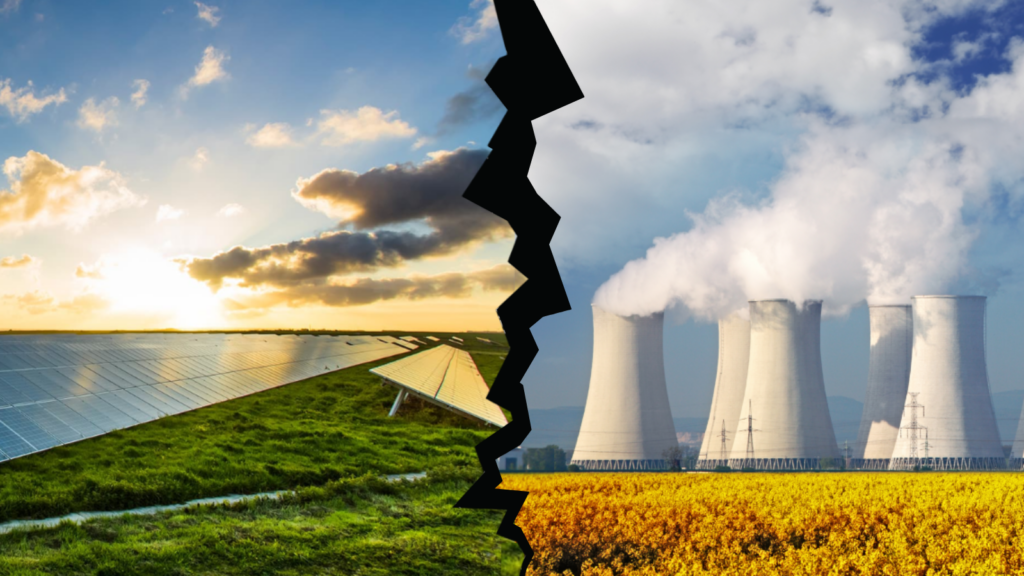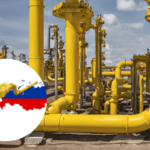Content:
With fossil fuels diminishing and climate change up in arms, the world is looking for energy sources that are more environmentally clean that will be the new champion of our global energy war. This is where solar and nuclear energy come in. Is one better than the other, or do they both serve a purpose in their ways?
As we explore the future of clean energy, it’s important to delve into key questions surrounding these two options. Below, we will examine six critical questions that will shed light on the strengths, weaknesses, and potential of both solar and nuclear energy as they work to shape the future of our global energy landscape.

How much investment is required for the infrastructure of solar and nuclear power?
Solar Energy
The investment required for a solar farm depends on several factors, including land acquisition, equipment, installation, and ongoing operational costs. The average cost per watt for utility-scale solar farms ranges from $0.89 to $1.01. Based on this, the total investment for a solar farm can vary widely depending on the size and scope of the project. Here are some examples of the total investment needed for different-sized solar farms:
1 MW solar farm: $890,000 – $1,010,000
5 MW solar farm: $4,450,000 – $5,050,000
10 MW solar farm: $8,900,000 – $10,100,000
These estimates can fluctuate based on location, design, and local market conditions. In addition, the ongoing maintenance costs of solar farms are typically estimated at 1-2% of the total capital cost of the solar farm per year. This includes routine inspections, cleaning, panel repairs, inverter replacements, and other operational activities.
Nuclear Energy
The investment required for a nuclear power plants is significantly higher compared to solar farms. The cost of nuclear power is often broken down into capital costs and operating costs. Capital costs include site preparation, engineering, manufacturing, construction, commissioning, and financing. Operating costs include fuel costs (from uranium mining to fuel fabrication), maintenance, decommissioning, and waste disposal. The International Atomic Energy Agency (IAEA) estimates that annual investments in nuclear energy currently stand at around $50 billion. However, to meet future capacity goals, this figure needs to increase to at least $125 billion per year. Building a new nuclear power plant typically costs between $6 billion to $9 billion, including expenses for site preparation, construction, regulatory compliance, and safety measures. Additionally, ongoing operational and maintenance costs are substantial, with annual expenses typically around $128 million per plant. For example, the investment cost for the Hinkley Point C nuclear power plant in the UK has increased significantly over time. The latest estimates place the total cost at GBP 31 to 34 billion (approximately USD 41.6 to 47.9 billion) in 2024 prices. This is a substantial rise from the initial estimate of GBP 18 billion in 2015 prices.
How do solar and nuclear energy differ in terms of power generation efficiency?
Solar Energy
Solar PV systems convert sunlight directly into electricity. While it’s a clean and renewable energy source, its efficiency is influenced by several factors:
- Solar Irradiance:The intensity of sunlight, measured in watts per square meter, varies significantly based on geographical location, time of day, and atmospheric conditions.
- Panel Efficiency:Modern monocrystalline silicon solar panels typically have efficiencies ranging from 18% to 22%, meaning they convert 18-22% of the sunlight they receive into electricity.
System Losses: Losses occur throughout the solar energy system, including in inverters, wiring, and energy storage, reducing the overall efficiency.

Nuclear Energy
Nuclear power plants generate electricity through controlled nuclear fission. Factors affecting nuclear power plant efficiency include:
- Thermal Efficiency:This is the ratio of electrical energy produced to the thermal energy released in the nuclear reaction. Modern nuclear power plants typically have thermal efficiencies around 33%.
- Plant Load Factor: The plant load factor measures how often a power plant operates at its maximum capacity. Nuclear power plants generally have high load factors, meaning they operate at a consistent level for extended periods.

Nuclear and solar energy each have their own strengths. Nuclear power plants are highly efficient, stable, and can generate large amounts of electricity from relatively small amounts of fuel, with a long operational lifespan. Solar energy, while renewable and clean, has lower efficiency but produces less environmental impact. Nuclear energy generates radioactive waste, while solar panels’ production and disposal may pose environmental concerns. The best energy choice depends on factors like geographic location, energy demand, and economic considerations.
What are the environmental impacts of solar and nuclear energy?
Solar Energy
- Positive Environmental Impacts:
- Zero Greenhouse Gas Emissions:Solar energy generates electricity directly from sunlight, resulting in zero greenhouse gas emissions during operation.
- Renewable Resource:Solar energy is an abundant and virtually inexhaustible resource, contributing to long-term energy sustainability.
- Reduced Land Use:While large-scale solar farms require significant land, advances in technology, such as bifacial panels and floating solar farms, are reducing the land footprint.
- Negative Environmental Impacts:
- Material and Energy Intensity:Solar panel production requires energy-intensive processes and materials, including silicon, metals, and chemicals. However, the embodied energy of solar panels is rapidly decreasing.
- Hazardous Materials:Some solar panel components, such as cadmium telluride, can be hazardous if not disposed of properly.
- Water Usage:Solar panel manufacturing and cleaning, especially in arid regions, can consume significant amounts of water.

Nuclear Energy
- Positive Environmental Impacts:
- Low Greenhouse Gas Emissions:Nuclear power generates electricity with minimal greenhouse gas emissions, contributing to climate change mitigation.
- High Energy Density:Nuclear fuel has a very high energy density, allowing for compact power plants and efficient energy production.
- Negative Environmental Impacts:
- Radioactive Waste:Nuclear power generates radioactive waste that requires long-term storage and disposal in specialized facilities.
- Thermal Pollution:Nuclear power plants discharge heated water into nearby bodies of water, which can harm aquatic ecosystems.
- Risk of Accidents:Although rare, nuclear accidents, such as those at Chernobyl and Fukushima, can have catastrophic environmental and health consequences.
- Proliferation Risks:The nuclear fuel cycle can be used to produce materials for nuclear weapons, raising concerns about nuclear proliferation.

Both solar and nuclear energy offer significant advantages in terms of low carbon emissions. However, they also present unique environmental challenges. The optimal choice of energy source depends on a variety of factors, including regional resources, technological advancements, and societal priorities. A balanced energy mix that combines renewable energy sources like solar with low-carbon nuclear power can help mitigate climate change and ensure a sustainable energy future.
How do solar and nuclear power systems perform in extreme weather conditions?
Solar Energy:
Solar power systems are generally resilient to extreme weather conditions, but their performance can vary depending on factors such as wind speed, temperature, hail, and flooding.
High Winds and Storms:
Utility-scale solar farms typically withstand wind speeds of up to 50 m/s (180 km/h or 112 mph) without significant damage. Panels are often rated to withstand hurricane-force winds, but localized stresses may occur at wind speeds above 60 m/s (216 km/h or 134 mph).
Hailstorms:
Solar panels are highly resistant to hail. Manufacturers typically guarantee that panels can withstand hailstones up to 25 mm in diameter, equivalent to the size of a marble. However, larger hailstones, up to 50 mm, can cause significant damage, especially if they hit with high velocity. Panels are tested for impact resistance with simulated hailstones traveling at speeds of 23 m/s (82.8 km/h or 51.5 mph).
High Temperatures:
Solar panels are designed to operate in temperatures as high as 85°C (185°F), but performance can degrade under extreme heat. High ambient temperatures (e.g., 40-45°C or 104-113°F) can cause a 20-30% reduction in energy output due to the “temperature coefficient” effect, where higher temperatures reduce the efficiency of solar cells.
Flooding:
Solar power systems are generally designed to handle rain and some flooding. However, severe floods can disrupt their operation. Most solar farms are located in areas where flooding risks are minimal, and drainage systems are implemented to prevent water accumulation.
Lightning:
Solar panels are not immune to lightning strikes, but the likelihood of direct strikes is low. Most modern systems have lightning protection (e.g., grounding and surge protection) built into the design. While a direct lightning strike could damage a panel, the built-in protection mechanisms ensure that significant damage is rare.
Nuclear Energy:
Nuclear power plants are built with strong resilience, but continuous improvements and strict regulatory oversight ensure that they remain safe and reliable in the face of extreme weather events.
Earthquakes:
Nuclear plants are built to handle strong seismic activity. For example, plants in seismically active regions, like Japan and California, are designed to withstand earthquakes of up to 7.0 magnitude. The Fukushima Daiichi plant, for instance, withstood a 7.1 magnitude earthquake in 2011 but was impacted by the tsunami.
Hurricanes and High Winds:
Plants in hurricane-prone areas are built to resist wind speeds of up to 300 km/h (186 mph). For example, the Vogtle Nuclear Plant in Georgia is designed to handle winds up to 402 km/h (250 mph).
Flooding:
Nuclear plants are typically located above expected flood levels with protective measures in place. After the 2011 Fukushima disaster, where flooding caused significant damage, new plants are being designed with higher flood protection, including barriers up to 18 meters tall. Plants are also required to maintain cooling systems even when submerged in water.
High Temperatures and Heatwaves:
Nuclear plants are equipped to operate in temperatures as high as 40°C–45°C (104°F–113°F). However, during heatwaves, cooling systems can be affected. In France during the 2003 heatwave, plants had to reduce their output by 20-30% to avoid overheating.
Tsunamis:
Plants near coastlines are designed with protections against tsunamis. The Fukushima Daiichi plant, which was designed to withstand a tsunami of up to 5.7 meters (18.7 feet), was overwhelmed by a tsunami that reached 14 meters (46 feet). Newer plants are being designed with even taller barriers to prevent similar disasters.

What are the safety risks associated with solar and nuclear energy?
Both solar and nuclear energy are considered to be safe in many respects, but each has its own set of risks. Below are the key safety concerns associated with these energy sources, along with relevant statistics.
Solar Energy:
Electrical Hazards and Fire Risks:
During installation, solar systems are connected to high-voltage electricity, which can lead to electrical shocks if not properly handled. Faulty wiring or poor installations can also result in fires, although these incidents are rare.
Panel Degradation and Toxic Materials:
Over time, solar panels degrade and lose efficiency. The materials used, such as cadmium and silicon, can pose environmental risks if not disposed of properly. The risk of releasing hazardous materials is extremely low, with less than 1% of solar panels failing in ways that could release toxic substances.
Nuclear Energy:
Nuclear energy is a highly efficient but complex energy source with significant safety risks that must be carefully managed.
Nuclear Accidents and Radiation Exposure:
The risk of nuclear accidents, such as the Chernobyl and Fukushima disasters, remains the most significant safety concern. For example, the Chernobyl disaster released about 5% of the reactor’s radioactive material, affecting over 200,000 people. While the likelihood of such accidents is low, the impact can be catastrophic.
Nuclear Waste Disposal and Security Risks:
Nuclear waste remains hazardous for thousands of years, and inadequate storage or disposal could lead to contamination. As of 2020, the U.S. alone had accumulated over 90,000 metric tons of nuclear waste, with no permanent disposal facility in place.
Cost of Safety Measures:
The cost of ensuring nuclear safety is extremely high. Constructing a nuclear plant typically costs over $6 billion, with 20-30% of the cost allocated to safety systems. Ongoing maintenance and security can account for up to 50% of the operational cost, making nuclear power one of the most expensive energy sources to maintain in terms of safety infrastructure.
While solar energy risks are relatively low and manageable, nuclear energy comes with more serious risks, particularly in terms of accidents, waste disposal, and security. Both energy sources are generally safe if handled properly, but the consequences of failure in nuclear energy can be far-reaching, making safety protocols and technological advancements essential for both industries.
What are the application ranges of solar and nuclear energy?
Solar Energy
Residential: Solar panels are widely used in residential buildings for rooftop installations, providing clean energy for homes. For example, a typical 5 kW residential solar system can produce around 6,000-8,000 kWh annually.
Commercial and Industrial: Large-scale solar installations are common in commercial and industrial sectors, helping reduce electricity costs and carbon footprints. The Tesla Gigafactory in Nevada aims to be powered entirely by renewable energy, including a massive solar array.
Utility-Scale: Utility-scale solar farms generate significant amounts of electricity. The Bhadla Solar Park in India has a capacity of 2,245 MW, making it one of the largest solar parks in the world.
Off-Grid Applications: Solar energy is essential for off-grid applications, providing electricity in remote or rural areas. The World Bank’s Lighting Global program has supported over 160 million people with off-grid solar products.
Transportation: Solar energy is used in transportation, including solar-powered electric vehicles and solar charging stations. The Solar Impulse 2 aircraft completed a solar-powered flight around the world in 2016.
Nuclear Energy
Base Load Power Generation: Nuclear power plants provide a large and consistent amount of electricity. The Bruce Nuclear Generating Station in Canada has a capacity of 6,234 MW.
Research and Medical Applications: Nuclear energy is critical in research and medical fields, producing isotopes for medical diagnostics and treatment. Radiation therapy for cancer treatment also relies on nuclear technology.
Desalination: Nuclear energy can be used for desalination, producing fresh water from seawater. Some nuclear power plants in the Middle East are combined with desalination facilities.
Space Exploration: Nuclear power is utilized in space exploration, providing energy for spacecraft and planetary rovers. The Curiosity rover and the Perseverance rover on Mars are powered by radioisotope thermoelectric generators (RTGs).
Maritime Propulsion: Nuclear energy is used in naval vessels, particularly submarines and aircraft carriers. The U.S. Navy’s Nimitz-class aircraft carriers are powered by nuclear reactors, allowing them to operate for over 20 years without refueling.
As the world faces the dual challenges of diminishing fossil fuel resources and escalating climate change, the search for clean energy solutions has intensified. Solar energy, with its scalability and minimal environmental impact during operation, stands out as a pivotal solution for achieving a clean and sustainable energy future. In contrast, while nuclear energy offers high efficiency and reliability, it grapples with challenges such as safety concerns, waste disposal, and significant upfront costs. A balanced energy mix that integrates both solar and nuclear technologies will be essential in mitigating climate change and securing a sustainable energy future for generations to come.
Since 2008, Maysun Solar has been at the forefront of producing high-quality photovoltaic modules, contributing to the global transition to clean energy. Our range of solar panels—including IBC, HJT, and TOPCon technologies, as well as innovative balcony solar panels—are crafted using cutting-edge technology, delivering exceptional performance and guaranteed quality. Maysun Solar has successfully established offices and warehouses in multiple countries, forging long-term partnerships with leading installers. As the world increasingly embraces both solar and nuclear energy as key pillars of a sustainable future, we are committed to supporting this transition with reliable, efficient solar solutions. For the latest quotes on solar panels or any photovoltaic-related inquiries, please contact us. We are dedicated to serving you, ensuring our products provide the assurance of a cleaner, more sustainable energy future.
Reference:
Adamji, M. (2024c, November 8). The future of nuclear financing: A turning point for investment in clean energy. Passle. https://sustainablefutures.linklaters.com/post/102jnrk/the-future-of-nuclear-financing-a-turning-point-for-investment-in-clean-energy
Heltsley, K. (2024b, August 19). How much investment do you need for a solar farm? ItekEnergy. https://www.itekenergy.com/solar-panels/cost-requirements-for-solar-farms/
Mecklin, J. (2019, June 21). Why nuclear power plants cost so much—and what can be done about it – Bulletin of the Atomic Scientists. Bulletin of the Atomic Scientists. https://thebulletin.org/2019/06/why-nuclear-power-plants-cost-so-much-and-what-can-be-done-about-it/
Bošnjaković, M., Stojkov, M., Katinić, M., & Lacković, I. (2023). Effects of extreme weather conditions on PV systems. Sustainability, 15(22), 16044. https://doi.org/10.3390/su152216044
Wikipedia contributors. (2024, November 19). Hinkley Point C nuclear power station. https://en.wikipedia.org/wiki/Hinkley_Point_C_nuclear_power_station
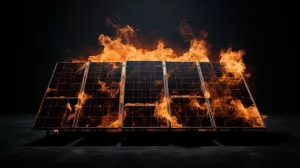
Photovoltaic Fire Safety Guide: How to Reduce the Risk of Power Plant Fires?
The risk of fire in photovoltaic power plants is on the rise. This article, based on European policy standards, provides a detailed explanation of design optimization, operation and maintenance strategies, and emergency response measures to enhance fire safety levels.
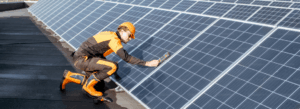
How to Design Low Maintenance High Yield Commercial and Industrial Photovoltaic Systems
How to build low-maintenance high-return photovoltaic plants This article analyzes the cost challenges and optimization paths of commercial and industrial photovoltaics in Europe helping enterprises achieve payback within 5–6 years and steadily increase long-term returns
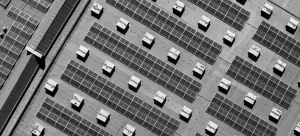
How Building-Integrated Photovoltaics (BIPV) is Changing the Commercial and Industrial Rooftop Solar Market
BIPV in Europe is reshaping the landscape of commercial and industrial rooftop photovoltaics, integrating building and power generation functions while offering policy incentives, economic returns, and ESG value. This article analyzes the advantages of BIPV in technological innovation, business models, and investment returns, helping enterprises seize the opportunity for green transformation.

How to Effectively Clean and Intelligently Maintain Photovoltaic Systems for Optimal Performance?
Explore how scientific cleaning and intelligent maintenance can ensure the efficient operation of commercial and industrial photovoltaic systems. Practical advice covers module cleaning frequency, monitoring system configuration, and long-term strategies for energy savings and performance enhancement.

2025 European Photovoltaic Policy Map: Deployment Paths and Regional Strategies for Commercial and Industrial Photovoltaics
A comprehensive analysis of the 2025 European commercial and industrial photovoltaic policy map, focusing on deployment strategies, incentive comparisons, and zero-investment models to support businesses in achieving an efficient and green transition.

Empowering Factories with Solar Energy A Strategic Tool for Controlling Production Electricity Costs
Commercial and industrial solar is becoming a key solution for factories to reduce electricity costs and hedge against price fluctuations. This article systematically analyzes its deployment models, cost advantages, and sustainable value pathways.

